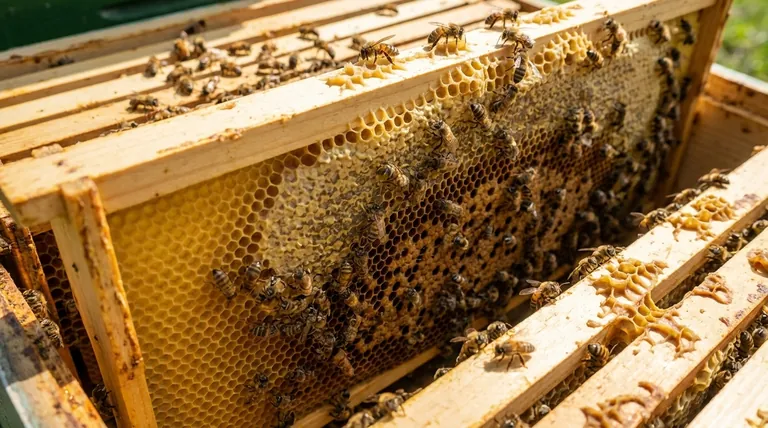Beeswax is the essential building block of the hive's entire internal structure. It is a substance secreted by worker bees that they meticulously shape into the iconic hexagonal comb, which serves as the colony's nursery, pantry, and communication network. A lack of beeswax fundamentally cripples the hive's ability to grow and sustain itself.
The core function of beeswax is to provide the physical architecture for every critical colony activity. Without sufficient wax comb, bees cannot effectively raise new brood or store the honey and pollen necessary for survival, directly impacting the hive's health and productivity.

The Role of Beeswax as the Hive's Foundation
Beeswax is not merely a byproduct; it is the material from which the colony constructs its home and future. Its importance is multifaceted, touching every aspect of a bee's life.
Building the Comb
Worker bees consume large amounts of honey to fuel special glands that secrete flakes of wax. They then chew and mold this wax to build the intricate and incredibly strong hexagonal cells of the honeycomb.
A Nursery for New Bees
The queen bee lays her eggs in these wax cells. The cells then serve as protected chambers where the larvae and pupae develop into the next generation of bees, making the comb essential for population growth.
The Pantry for Sustenance
Bees use the majority of the comb to store their food reserves. Cells are filled with nectar, which ripens into honey, and pollen, which provides essential proteins and nutrients for the colony.
Capping and Preservation
Once honey is ready, bees secrete a thin layer of fresh wax to cap the cell. This airtight seal protects the honey from moisture and bacteria, preserving it indefinitely for times when food is scarce.
The Consequences of a Beeswax Deficit
A shortage of beeswax, or the comb built from it, creates severe problems that can quickly lead to a colony's decline.
Stalled Colony Growth
Without enough empty cells, the queen has nowhere to lay eggs. This "brood-bound" condition dramatically slows the production of new bees, weakening the colony's workforce.
Inadequate Food Storage
A lack of comb means the colony cannot store enough honey and pollen. This is especially dangerous leading into winter or during periods of nectar dearth, when the bees rely entirely on their stored food.
Weakened Hive Structure
Insufficient wax can lead to poorly constructed or incomplete comb. This structural weakness can compromise the integrity of the hive and make it more difficult for the bees to manage their environment.
Practical Solutions for Beekeepers
When a hive is struggling to produce enough wax, a beekeeper must intervene to provide the necessary resources.
Provide Beeswax Foundations
The most common solution is to install beeswax foundations—thin sheets of beeswax imprinted with a hexagonal pattern. This gives the bees a blueprint, saving them an immense amount of energy and time they would have spent building the comb from scratch.
Transfer Resources from a Stronger Hive
A beekeeper can take a frame of fully "drawn" comb from a strong, established hive and give it to a weaker one. This provides immediate space for the queen to lay eggs or for workers to store food.
Purchase and Apply Raw Beeswax
While less common for internal structure, beekeepers can purchase raw beeswax. It is often used to coat new plastic frames or foundations, encouraging the bees to accept and build upon them more quickly.
Understanding the Trade-offs
Managing beeswax is a balancing act that requires understanding its cost to the colony.
The High Energy Cost of Production
Producing wax is incredibly resource-intensive. It is estimated that bees must consume six to eight pounds of honey to produce just one pound of beeswax. Providing foundations helps conserve these vital energy stores for other tasks.
Foundation Quality is Critical
Using low-quality or contaminated foundations can introduce pesticides or diseases into the hive. Always source pure beeswax foundations from reputable suppliers to protect your colony's health.
Natural Comb vs. Foundation
Some beekeepers prefer "foundationless" frames, which allow bees to build comb naturally. While this can result in a healthier hive environment, it requires a very strong nectar flow and a robust colony, as the bees must expend far more energy.
Making the Right Choice for Your Hive
Your approach to beeswax management should align with the specific needs of your colony.
- If your primary focus is establishing a new or weak colony: Provide high-quality beeswax foundations to conserve the bees' energy and accelerate their growth.
- If your primary focus is maximizing honey production in a strong hive: Ensure ample space with drawn comb or foundations so bees can immediately store incoming nectar instead of building wax.
- If your primary focus is natural beekeeping with a robust colony: Allow bees to build their own comb on foundationless frames, but be prepared to supplement with feed during periods of low nectar flow.
Effectively managing beeswax is fundamental to partnering with your bees for a healthy, resilient, and productive hive.
Summary Table:
| Key Function of Beeswax | Consequence of Lack | Primary Solution |
|---|---|---|
| Comb Construction | Poor hive structure, instability | Provide beeswax foundations |
| Brood Rearing (Nursery) | Stalled colony growth, weak workforce | Transfer drawn comb from a strong hive |
| Food Storage (Pantry) | Inadequate honey/pollen reserves, starvation risk | Ensure ample space with drawn comb or foundations |
| Capping & Preservation | Honey spoilage, moisture issues | Support wax production with proper nutrition |
Ensure your apiary's success with the right foundation. A steady supply of high-quality beeswax is critical for hive health and honey production. HONESTBEE supplies commercial apiaries and beekeeping equipment distributors with premium, pure beeswax foundations and essential beekeeping supplies through our wholesale-focused operations. Let us help you build stronger, more productive colonies.
Contact HONESTBEE today to discuss your wholesale supply needs and secure the foundations for your success.
Visual Guide

Related Products
- Beeswax Foundation Sheets Beehive Foundation for Wholesale
- Manual Beeswax Comb Foundation Machine Wax Foundation Mill Embossing Machine
- Colorful Silicone Beeswax Foundation Mold Mould for Beekeeping
- Professional Frame Preparation: The HONESTBEE Electric Wire Embedder
- Food Grade Plastic bee Foundation for Bee Frames
People Also Ask
- How do you store beeswax foundation? Prevent Wax Moth Damage and Preserve Quality
- What happens if foundation is given to colonies during a nectar dearth? Avoid Wasted Equipment and Stressed Bees
- What are the sizes of natural worker and drone cells? Guide to Natural Beehive Architecture
- How do beeswax foundations save bees time and energy? Boost Hive Productivity & Honey Yield
- What is beeswax foundation used for? A Guide to Efficient Hive Management



















